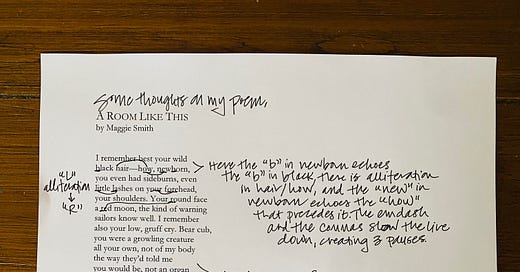Hi, Friend.
This week I’ve annotated “A Room Like This,” a poem from my last collection, Goldenrod. One of the things I love doing in this newsletter is sharing behind-the-scenes looks at poems and essays. When I read a poem or hear a song or see a piece of visual art that resonates with me, I want to know how it happened. How did it begin? What choices did the artist consider? Most of the time, we can only guess at the answers to these questions, because we aren’t invited to peek behind the curtain. This is a peek behind the curtain.
The first thing you might notice about the poem is that there are no stanza divisions. If you’ve been following along with For Dear Life, you know my favorite stanza is the couplet. I love white space. But as I drafted this poem, I decided the meandering quality and the surprising turn it takes were best served by a single stanza. I have no doubt, knowing my affection for short stanzas, that I tested out couplets and perhaps even tercets, before landing on a single stanza. I stand by this choice for the poem.
I always make final choices about line and sound while sitting at my laptop, reading the poem aloud to myself over and over again, making changes in service of the rhythm, music, and pacing. Here you can see several places with assonance (vowel sounds, like the long “I” in pines and fire); consonance (consonant sounds, like the “L” in smell and soil); and alliteration (consonant sounds specifically at the beginning of word, like the “L” in little and lashes).
I broke the line to create pauses where I wanted them, slowing the poem down, and to build tension and suspense. Look at the line endings I’ve marked with arrows. Here the reader has questions that they must read on to have answered. Some lines I liked on their own because they have their own integrity and meaning apart from the rest of the sentence. For example, “I’m thinking I don’t want to die” means something on its own, so that line feels charged. When the reader reaches the end of the sentence on the next line—“in a room”—the meaning is clarified, even transformed.
Here’s a clean copy of the poem, from the book.
Paid subscribers should keep an eye out for a special post later this week that includes the initial notes for “A Room Like This”—scans of the original handwritten pages from my writing notebook, circa 2019—and an in-depth discussion of the inspiration behind the poem and the ways it surprised me as it unfolded.
If you’d like to receive that post, and if For Dear Life has been useful for you as a writer or teacher, I hope you’ll consider becoming a paid subscriber. Either way, I’m glad you’re here. And if you’re reading (or rereading) Goldenrod, check out the playlist I made for it. I’ve been listening to it so much on walks and in the car these days. It feels summery to me.
Happy writing and reading (and listening!)—
Maggie






I love this union of meandering and arriving — how we take the journey with the narrator, trusting our guide won’t leave us on the path. I love how the form of the poem mirrors the creative process itself — often I find the hardest part to be taking all those loose ends from ‘unfinished’ alternate paths and deciding whether to sew them in or cut them free.
Thank you, Maggie. I appreciate you.